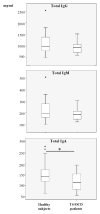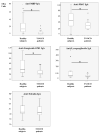Children with Tourette's syndrome may suffer immunoglobulin A dysgammaglobulinemia: preliminary report
- PMID: 20006327
- PMCID: PMC3974615
- DOI: 10.1016/j.biopsych.2009.09.034
Children with Tourette's syndrome may suffer immunoglobulin A dysgammaglobulinemia: preliminary report
Abstract
Background: Postinfectious autoimmunity has been implicated in Tourette's syndrome and obsessive-compulsive disorder (TS/OCD), whereas increased frequency of upper respiratory tract infections (URTI) in TS/OCD patients suggests immune deficiency. We hypothesized that antineuronal antibodies may be elevated in patients (reflecting autoimmune processes), and levels of total immunoglobulins (Igs) may be decreased (reflecting immune deficiency).
Methods: We analyzed plasma of TS/OCD patients (n = 24) and healthy age- and sex-matched control subjects (n = 22) by enzyme-linked immunosorbent assay (ELISA) for the levels of total and specific IgG, IgM, and IgA against antigens previously identified in multiple sclerosis (myelin basic protein and myelin-associated glycoprotein) and Sydenham's chorea (ganglioside-GM1, lysoganglioside, and tubulin).
Results: Total IgA was decreased in TS/OCD patients (median 115 mg/100 mL) compared with control subjects (141 mg/100 mL; p = .02). Specific IgA against all antigens, except tubulin were also decreased in the patients (MPB 0 vs. 13 [ELISA units [EU]; myelin-associated glycoprotein 29 vs. 44 EU, p = .04; ganglioside GM1 21 vs. 35 EU, p = .01; lysoganglioside 44 vs. 56 EU, p = .03; tubulin 44 vs. 44 EU, p = .8). The levels of total IgA and anti-myelin basic protein (MBP) IgA were significantly lower in the subgroup of pediatric autoimmune neuropsychiatric disorder associated with Streptococcus (PANDAS) cases (n = 10) than in non-PANDAS cases (n = 9; total IgA 98 mg/100 mL vs. 133 mg/mL, p = .03; anti-MBP IgA 1 vs. 6 EU, p = .03) or healthy control subjects (total IgA 141 mg/100 mL, p = .02; anti-MBP IgA 13 EU, p = .005).
Conclusions: At least some TS/OCD patients may suffer IgA dysgammaglobulinemia, possibly rendering the children more prone to URTI.
Copyright 2010 Society of Biological Psychiatry. Published by Elsevier Inc. All rights reserved.
Conflict of interest statement
AV is an owner of Immunosciences Laboratory, Inc. All other authors report no biomedical financial interests or potential conflicts of interest.
Figures



Similar articles
-
Immunoglobulin A Dysgammaglobulinemia Is Associated with Pediatric-Onset Obsessive-Compulsive Disorder.J Child Adolesc Psychopharmacol. 2019 May;29(4):268-275. doi: 10.1089/cap.2018.0043. Epub 2019 Mar 20. J Child Adolesc Psychopharmacol. 2019. PMID: 30892924 Free PMC article.
-
Tourette's syndrome: a cross sectional study to examine the PANDAS hypothesis.J Neurol Neurosurg Psychiatry. 2003 May;74(5):602-7. doi: 10.1136/jnnp.74.5.602. J Neurol Neurosurg Psychiatry. 2003. PMID: 12700302 Free PMC article.
-
B lymphocyte antigen D8/17: a peripheral marker for childhood-onset obsessive-compulsive disorder and Tourette's syndrome?Am J Psychiatry. 1997 Mar;154(3):402-7. doi: 10.1176/ajp.154.3.402. Am J Psychiatry. 1997. PMID: 9054790
-
Immune mechanisms in pediatric neuropsychiatric disorders. Tourette's syndrome, OCD, and PANDAS.Child Adolesc Psychiatr Clin N Am. 1999 Oct;8(4):767-75. Child Adolesc Psychiatr Clin N Am. 1999. PMID: 10553202 Review.
-
On defining Sydenham's chorea: where do we draw the line?Biol Psychiatry. 2000 May 15;47(10):851-7. doi: 10.1016/s0006-3223(00)00843-x. Biol Psychiatry. 2000. PMID: 10807957 Review.
Cited by
-
Pediatric Acute-Onset Neuropsychiatric Syndrome (PANS) and Pediatric Autoimmune Neuropsychiatric Disorders Associated with Streptococcal Infections (PANDAS): Immunological Features Underpinning Controversial Entities.Children (Basel). 2024 Aug 27;11(9):1043. doi: 10.3390/children11091043. Children (Basel). 2024. PMID: 39334578 Free PMC article. Review.
-
Immunological Dysfunction in Tourette Syndrome and Related Disorders.Int J Mol Sci. 2021 Jan 16;22(2):853. doi: 10.3390/ijms22020853. Int J Mol Sci. 2021. PMID: 33467014 Free PMC article. Review.
-
Searching for host immune-microbiome mechanisms in obsessive-compulsive disorder: A narrative literature review and future directions.Neurosci Biobehav Rev. 2021 Jun;125:517-534. doi: 10.1016/j.neubiorev.2021.02.034. Epub 2021 Feb 24. Neurosci Biobehav Rev. 2021. PMID: 33639178 Free PMC article. Review.
-
What Does Immunology Have to Do With Normal Brain Development and the Pathophysiology Underlying Tourette Syndrome and Related Neuropsychiatric Disorders?Front Neurol. 2020 Sep 16;11:567407. doi: 10.3389/fneur.2020.567407. eCollection 2020. Front Neurol. 2020. PMID: 33041996 Free PMC article. Review.
-
Antibody binding to neuronal surface in Sydenham chorea, but not in PANDAS or Tourette syndrome.Neurology. 2011 Apr 26;76(17):1508-13. doi: 10.1212/WNL.0b013e3182181090. Epub 2011 Mar 16. Neurology. 2011. PMID: 21411742 Free PMC article.
References
-
- Snider LA, Swedo SE. PANDAS: Current status and directions for research. Mol Psychiatry. 2004;9:900–907. - PubMed
-
- Kirvan CA, Swedo SE, Heuser JS, Cunningham MW. Mimicry and autoantibody-mediated neuronal cell signaling in Sydenham chorea. Nat Med. 2003;9:914–920. - PubMed
-
- Dale RC, Candler PM, Church AJ, Wait R, Pocock JM, Giovannoni G. Neuronal surface glycolytic enzymes are autoantigen targets in post-streptococcal autoimmune CNS disease. J Neuroimmunol. 2006;172:187–197. - PubMed
Publication types
MeSH terms
Substances
Grants and funding
LinkOut - more resources
Full Text Sources
Medical
Miscellaneous

